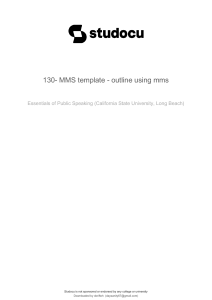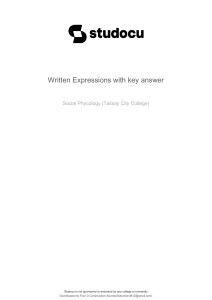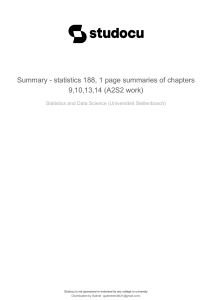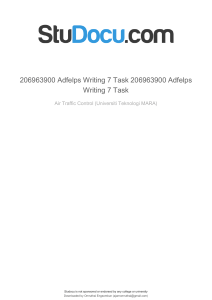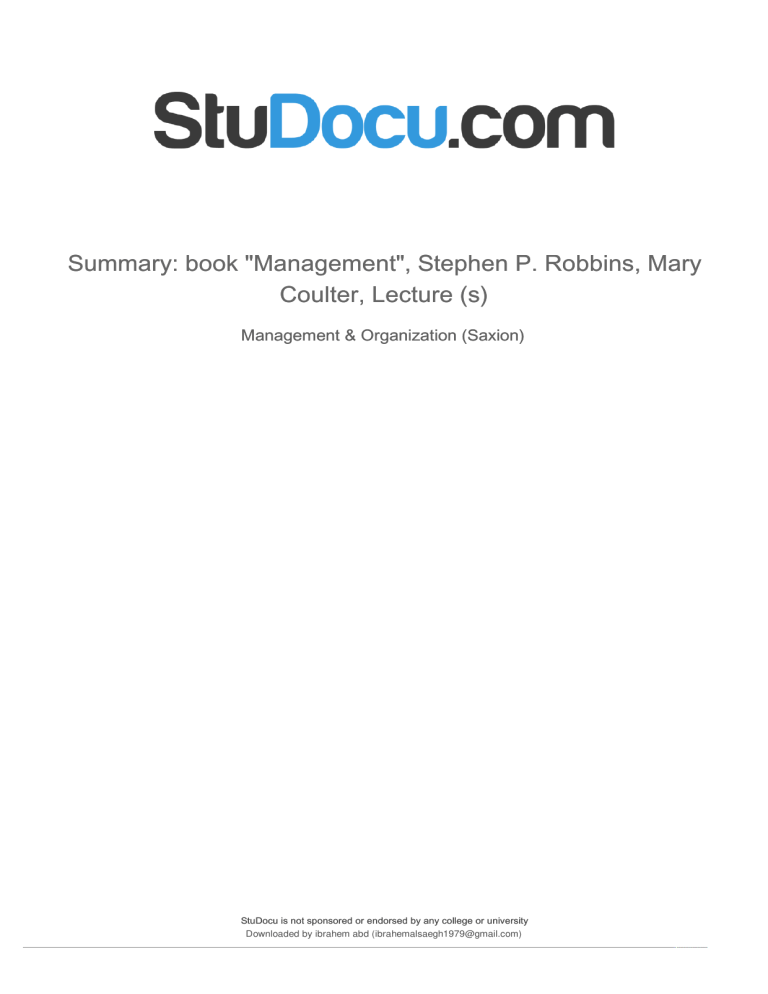
Summary: book "Management", Stephen P. Robbins, Mary Coulter, Lecture (s) Management & Organization (Saxion) StuDocu is not sponsored or endorsed by any college or university Downloaded by ibrahem abd (ibrahemalsaegh1979@gmail.com) Summary management and organisation Chapter 1 A good organisation has the following 3 aspects: An organization: a deliberate arrangement of people to accomplish some specific purpose, controlled by its management. Management has the task to coordinate the organization towards accomplishing organizational goals. Activities are completed efficiently and effectively by others. A manager: someone who coordinates and oversees the work of other people in order to accomplish organizational goals. First- line managers: the lowest level of management who manage the work of non-managerial employees and typically are directly or indirectly involved with producing the organization’s products or servicing the organization’s customers. Middle managers: manager between the lowest level and top levels of the organization who manage the work of first-line managers Top managers: managers at or near the upper levels of the organization structure who are responsible for making organization wide decisions and establishing the goals and plans that affect the entire organization. Efficiency: doing things right or getting the most output from the least amount of inputs Effectiveness: doing the right things, or completing activities so that organizational goals are reached. Management functions (Fayol) Planning Define goals, setting goals, developing plans and strategy to coordinate activities. Organizing Deciding what needs to be done, and how and who will do it Leading Motivating, leading. (Conflicts) Controlling Monitoring activities, to ensure reached as planned Achieving the organizations stated purposes Management roles (Mintzergs) Interpersonal roles: managerial roles that involve people and other duties that is ceremonial and symbolic in nature. Roles: Figurehead, leader, liaison (first line) Informational roles: managerial roles that involve collecting, receiving, and disseminating information. Roles: monitor, disseminator, spokesperson (middle) Decisional roles: managerial roles that revolve around making choices. Roles, Entrepreneur disturbance handler resource allocator negotiator (top) Downloaded by ibrahem abd (ibrahemalsaegh1979@gmail.com) Management skills Conceptual skills, the ability to think and to conceptualize about abstract and complex situations. (Top managers) Human skills, the ability to work well with other people individually and in a group(middle managers, but all managers need it) Technical skills, job-specific knowledge and techniques needed to proficiently perform work tasks. (first line managers) O Chapter 2 Classical approach: making organizations and workers as efficient as possible Scientific management, one best way to do your job. The four principles of scientific management 1. The development of a true science 2. The scientific selection of the workman 3. The scientific education and development of the workman 4. Intimate and friendly cooperation between the management and the men General administrative, an approach to management that focuses on describing what managers do and what constitutes good management practice. 1. Division of work (specialization increases output by making employees more efficient) 2. Authority (Managers must be able to give orders and authority gives them this right) 3. Discipline (Employees must obey and respect the rules that govern the organization) 4. Order (People and materials should be in the right place at the right time) 5. Equity (Managers should be kind and fair to their subordinates) *bureaucracy, a form of organization characterized by division of labor, a clearly defined hierarchy, detailed rules and regulations and impersonal relationships. (Division of labor, authority hierarchy, formal selection, formal rules and regulations, impersonality, career orientation) Page 45 Downloaded by ibrahem abd (ibrahemalsaegh1979@gmail.com) Quantitative approach: the use of quantitative techniques to improve decision making, within total quality management: a philosophy of management that is driven by continuous improvement and responsiveness to customer needs and expectations. 1. Intense focus on the customer, ( buyers) 2. Continual improvement, (quality management, never satisfied) 3. Process focused, (improve work processes and goods and services) 4. Improvement in the quality of everything ( after sales service of a company) 5. Accurate measurement (measure variables in organization operations) 6. Empowerment of employees, (people on the line improvement process) Behavioral approach Organizational behavior, a field of study that researches the actions (behavior) of people at work. What can lead to a higher productivity? Contemporary approaches Systems approach; a set of interrelated and interdependent parts arranged in a manner that produces a unified whole. 1. Open system that interact with their environment 2. Closed system that not interact with their environment Contingency approach: a management approach which says that organizations are different, face different situations, and require different ways of managing. Variables: Routine of task technology, environmental uncertainty, individual differences, organization size. Chapter 3 Omnipotent view of management: the view that managers are directly responsible for an organization success or failure Symbolic view: the view that much of an organization success or failure is due to external forces outside manager’s control Organizational culture: the shared values, principles, traditions, and ways of doing things that influence the way organizational members act. Every company has an organizational culture. How do employees learn about culture? Rituals, symbols, language and stories Culture can be defined as all the behaviours, ways of life, arts, beliefs and institutions of a population that are passed down from generation to generation.(values, heroes, rituals, cultural network even within a company) Innovative culture: Give the employees enough freedom, trust, join decision-making, etc. Downloaded by ibrahem abd (ibrahemalsaegh1979@gmail.com) Strong cultures: organizational cultures in which the key values are intensely held and widely shared Weak cultures: organizational cultures in which the key values are less intensely held and easier to change compared to a strong culture. Chapter 4/5 Multinational Corporation: connect global perspective. Companies expand but why? Different economies of scale on existing products, opportunities/unserved market, attack competitor in its home market, spread investment in new products. Parochialism: viewing the world solely through one’s own eyes and perspectives and not recognizing that others have different ways of living and working. Parochialism leads to an inability to recognize differences between people. Ethnocentric attitude: the parochialistic belief that the best work approaches and practices are those of the home country. (Global company, centralized management, global efficiency) Polycentric attitude: the view that the managers in the host country know the best work approaches and practices for running their business. (Multi-domestic cooperation, decentralized management in different countries). Geocentric attitude: a world-oriented on using the best approaches and people from around the globe. (Transnational/borderless organizations, eliminates geographic barriers, also in organizational structure). How organizations go international Global sourcing: purchasing materials or labor from around the world based on lowest cost Exporting: making products domestically and selling them abroad. Importing: purchase products made abroad and sell them domestically Licensing: an agreement in which an organization gives another organization the right to make or sell its products, using its technology or product specifications. Franchising: an agreement in which an organization gives another organization the right to use its name and operating methods. Strategic alliance: a partnership between an organization and a foreign company partner in which both share resources and knowledge in developing new products or building production facilities. Makes it easy to buy and sell goods between the members of the alliance Makes it harder for other countries to sell into the alliance A trade alliance has quotas- limit on the amount of goods that can be sold in the country Taxes- have tariffs on import products to make the product more expensive. Downloaded by ibrahem abd (ibrahemalsaegh1979@gmail.com) Social obligation: a firms engaging in social actions because of its obligation to meet certain economic and legal responsibilities Classical view: the view that managements only social responsibility is maximize profits Socioeconomic view: the view that management social responsibility goes beyond making profits and includes protecting and improving society’s welfare Social responsiveness: a firm engaging in social actions in response to some popular social need Social responsibility; a business intention, beyond its legal and economic obligations, to do the right things and act in ways that are good for society. A green management: a form of management in which managers consider the impact of their organization on the natural environment. Chapter 6 Decision making process, a decision is a choice from two or more alternatives Problem: an obstacle that makes achieving a desired goal or purpose difficult Identifying a problem 1. Problem identification (degree of problem) (most important part of decision making, do we really have a problem which is a treat to our company?) 2. Identifying decision criteria, criteria that define what’s important or relevant in resolving a problem. 3. Allocating weights to criteria 4. Developing alternatives 5. Analyzing alternatives 6. Selecting an alternative 7. Implementing the alternative 8. Evaluating decision effectiveness Evaluation of decision effectiveness Downloaded by ibrahem abd (ibrahemalsaegh1979@gmail.com) Structured problem: a straightforward, familiar and easily defined problem Programmed decision: repetitive decision that can be handled using a routine approach Unstructured problem: a problem that is new or unusual and for which information is incomplete Non-programmed decision: A unique and nonrecurring decision that requires a custom made solution Certainty: a situation in which a decision maker can make accurate decisions because all outcomes are known. (Ideal situation) Risk: a situation in which the decision maker is able to estimate the likelihood of certain outcomes. Under risk, managers have historical data from past personal experiences or secondary information that lets them assign probabilities to different alternatives. Uncertainty: a situation in which a decision maker has neither certainty nor reasonable probability estimates available. Maximax: Maximum profit outcome within the same strategy Maximin: Minimum profit outcome within the same strategy Minimax: Maximum profit outcome over the different strategies. Rational decision making: a type of decision making in which choices are logical and consistent and maximize value Bounded rationality: decision making that’s rational but limited by an individual’s ability to process information Satisfice: to accept solutions that is good enough. Downloaded by ibrahem abd (ibrahemalsaegh1979@gmail.com) Linear thinking: a decision style characterized by a person’s preference for using external data and facts and processing this information through rational, logical thinking Nonlinear thinking style: a decision style characterized by a person’s preference for internal sources of information and processing this information with internal insights, feelings, and hunches. Heuristics: rules of thumb that mangers use to simplify decision making Decision making errors and biases Overconfidence once success, always success Immediate gratification immediate results wanted Anchoring effect focus on initial information Selective perception biased perception Confirmation “That’s what I thought” Framing Highlighting points over others Availability Work on short term memory Representation “Kind of like last time” Randomness Create meaning out of random Sunk costs can’t correct the past Self-serving “It was me, all me!! Unless it went wrong” Hindsight “I would have known that!” Chapter 8 Strategy: The direction and scope of an organization over the long term, which achieves advantage for the organization through its configuration of resources within a changing environment and to fulfil stakeholder expectations.” Better performance Set out a course and deal with change One plan for everyone in the organization Strategic management: what managers do to develop an organization’s strategies. It’s important and it involves all management functions: planning, organizing, leading and controlling. Classic strategy by Michael porter: Best practice in daily work is good, but without a strategy you will not have competitive advantage, only price erosion. A strategy needs to be aimed at profit, continuity and (dynamic) change. You need to be able to improve yourself. Strategic management process: a six step process that encompasses strategic planning, implementation and evaluation. 1. Identify the organization’s current mission, goals, and strategies. 2. External analysis (opportunities and treats) SWOT 3. Internal analysis (strengths and weaknesses)SWOT 4. Formulate strategies 5. Implement strategies 6. Evaluate results Mission: a statement of the purpose of an organisation Resources: an organization assets that are used to develop, manufacture and deliver products to its customers Capabilities: an organization’s skills and abilities in doing the work activities needed in its business Core competencies: the organization’s major value creating capabilities that determine its competitive weapons. Downloaded by ibrahem abd (ibrahemalsaegh1979@gmail.com) Corporate strategies: an organizational strategy that specifies what businesses a company is in or wants to be in and what it wants to do with those businesses. Growth strategy: a corporate strategy that’s used when an organization wants to expand the number of markets served or products offered, either through its current business of through new businesses Stability strategy: a corporate strategy in which an organization continues to do what it is currently doing Renewal strategy: a corporate strategy designed to address declining performance Turnaround – When the problems are serious Retrenchment strategy – When the problems are small Competitive strategy: an organizational strategy for how an organization will compete in its business Strategic business units: the single businesses of an organization that are independent and formulate their own competitive strategies. Competitive advantage: the factor that an organization apart; it’s distinctive edge Functional strategies: the strategies used by an organization’s various functional departments to support the organization’s competitive strategy Strategy flexibility: the ability to recognize major external changes, to quickly commit resources, and to recognize when a strategic decision was a mistake. Downloaded by ibrahem abd (ibrahemalsaegh1979@gmail.com) Porters 5 forces Threats of new entrants: how likely is it that new competitor’s will come into the industry? Threat of substitutes: how likely is it that other industries products can be substituted for our industry products? Bargaining power of buyers: how much bargaining power do buyer’s (customers) have? Bargaining power of suppliers: how much bargaining power do suppliers have? Current rivalry: how intense is the rivalry among current industry competitors? Downloaded by ibrahem abd (ibrahemalsaegh1979@gmail.com) Chapter 8 Goals Stated goals: Official statements of what an organization says, and what it wants its various stakeholders to believe Real goals: Goals that an organization actually pursues, as defined by the actions of its members Plans Strategic plans: Plans that apply to the entire organization and establish the organization’s overall goals Operational plans: Plans that encompass a particular operational area of the organization Long-term plans: Plans with a time frame beyond three years Short-term plans: Plans covering one year or less Specific plans: Plans that are clearly defined and leave no room for interpretation Directional plans: Plans that are flexible and set out general guidelines Single-use plan: A one-time plan specifically designed to meet the needs of a unique situation Standing plans: Ongoing plans that provide guidance for activities performed repeatedly Planning approaches Formal planning department: A group of planning specialists whose sole responsibility is helping to write organizational plans Environmental scanning: Screening information to detect emerging trends. Competitor intelligence: Gathering information about competitors that allows managers to anticipate competitors’ actions than merely react to them. Goal setting Traditional goal setting: An approach to setting goals in which top managers set goals that then flow down through the organization and become sub goals for each organizational area Means-ends chain: An integrated network of goals in which the accomplishment of goals at one level serves as the means for achieving the goals, or ends, at the next level Management by objectives (MBO): A process of setting mutually agreed-upon goals and using those goals to evaluate employee performance Factors that determine ethical and unethical behavior Individual characteristics Issue intensity Organizational culture Structural variable Downloaded by ibrahem abd (ibrahemalsaegh1979@gmail.com)


